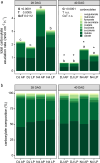Root exudation patterns of contrasting rice (Oryza sativa L.) lines in response to P limitation
- PMID: 39441370
- PMCID: PMC11499414
- DOI: 10.1007/s00425-024-04556-2
Root exudation patterns of contrasting rice (Oryza sativa L.) lines in response to P limitation
Abstract
Rice exudation patterns changed in response to P deficiency. Higher exudation rates were associated with lower biomass production. Total carboxylate exudation rates mostly decreased under P-limiting conditions. Within the rhizosphere, root exudates are believed to play an important role in plant phosphorus (P) acquisition. This could be particularly beneficial in upland rice production where P is often limited. However, knowledge gaps remain on how P deficiency shapes quality and quantity of root exudation in upland rice genotypes. We therefore investigated growth, plant P uptake, and root exudation patterns of two rice genotypes differing in P efficiency in semi-hydroponics at two P levels (low P = 1 µM, adequate P = 100 µM). Root exudates were collected hydroponically 28 and 40 days after germination to analyze total carbon (C), carbohydrates, amino acids, phenolic compounds spectrophotometrically and carboxylates using a targeted LC-MS approach. Despite their reported role in P solubilization, we observed that carboxylate exudation rates per unit root surface area were not increased under P deficiency. In contrast, exudation rates of total C, carbohydrates, amino acids and phenolics were mostly enhanced in response to low P supply. Overall, higher exudation rates were associated with lower biomass production in the P-inefficient genotype Nerica4, whereas the larger root system with lower C investment (per unit root surface area) in root exudates of the P-efficient DJ123 allowed for better plant growth under P deficiency. Our results reveal new insights into genotype-specific resource allocation in rice under P-limiting conditions that warrant follow-up research including more genotypes.
Keywords: Amino acids; Carbohydrates; Carboxylates; Phenolics; Phosphorus.
© 2024. The Author(s).
Conflict of interest statement
The authors declare that they have no known competing financial interests or personal relationships that could have influenced the work reported in this paper.
Figures




Similar articles
-
Root carboxylate exudation capacity under phosphorus stress does not improve grain yield in green gram.Plant Cell Rep. 2014 Jun;33(6):919-28. doi: 10.1007/s00299-014-1570-2. Epub 2014 Feb 4. Plant Cell Rep. 2014. PMID: 24493254
-
Contrasting development of lysigenous aerenchyma in two rice genotypes under phosphorus deficiency.BMC Res Notes. 2018 Jan 22;11(1):60. doi: 10.1186/s13104-018-3179-y. BMC Res Notes. 2018. PMID: 29357942 Free PMC article.
-
Malate exudation by six aerobic rice genotypes varying in zinc uptake efficiency.J Environ Qual. 2009 Oct 29;38(6):2315-21. doi: 10.2134/jeq2009.0043. Print 2009 Nov-Dec. J Environ Qual. 2009. PMID: 19875787
-
Enhancing phosphorus and zinc acquisition efficiency in rice: a critical review of root traits and their potential utility in rice breeding.Ann Bot. 2013 Jul;112(2):331-45. doi: 10.1093/aob/mcs217. Epub 2012 Oct 15. Ann Bot. 2013. PMID: 23071218 Free PMC article. Review.
-
Tree carbon allocation to root exudates: implications for carbon budgets, soil sequestration and drought response.Tree Physiol. 2025 Mar 28;45(4):tpaf026. doi: 10.1093/treephys/tpaf026. Tree Physiol. 2025. PMID: 40037284 Review.
Cited by
-
The Rice-Microbe Nexus: Unlocking Productivity Through Soil Science.Rice (N Y). 2025 Jun 20;18(1):56. doi: 10.1186/s12284-025-00809-0. Rice (N Y). 2025. PMID: 40540085 Free PMC article. Review.
-
Mobilization of Readily Exchangeable Organic P - A Potential Driver of Enhanced P Acquisition Efficiency in Upland Rice.J Soil Sci Plant Nutr. 2025;25(2):5324-5340. doi: 10.1007/s42729-025-02467-z. Epub 2025 May 19. J Soil Sci Plant Nutr. 2025. PMID: 40568342 Free PMC article.
References
-
- Ainsworth EA, Gillespie KM (2007) Estimation of total phenolic content and other oxidation substrates in plant tissues using Folin-Ciocalteu reagent. Nat Protoc 2:875–877. 10.1038/NPROT.2007.102 - PubMed
-
- Aulakh MS, Wassmann R, Bueno C, Kreuzwieser J, Rennenberg H (2001) Characterization of root exudates at different growth stages of ten rice (Oryza sativa L.) cultivars. Plant Biol 3:139–148. 10.1055/S-2001-12905
-
- Bhattacharyya P, Das S, Adhya TK (2013) Root exudates of rice cultivars affect rhizospheric phosphorus dynamics in soils with different phosphorus statuses. Commun Soil Sci Plant Anal 44:1643–1658. 10.1080/00103624.2013.769562
-
- Bishopp A, Lynch JP (2015) The hidden half of crop yields. Nat Plants 1:1–2. 10.1038/nplants.2015.117 - PubMed
-
- Bleiholder H, Weber E, Lancashire P, Feller C, Buhr L, Hess M, Wicke H, Hack H, Meier U, Klose R (2001) Growth stages of mono-and dicotyledonous plants. BBCH Monograph. Federal Biological Research Centre for Agriculture and Forestry, Berlin/Braunschweig
MeSH terms
Substances
Grants and funding
LinkOut - more resources
Full Text Sources

